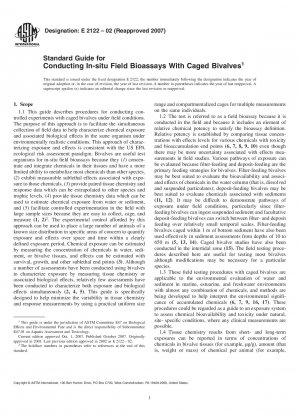ASTM E2122-02(2007)
Standard Guide for Conducting In-situ Field Bioassays With Caged Bivalves
- Standard No.
- ASTM E2122-02(2007)
- Release Date
- 2002
- Published By
- American Society for Testing and Materials (ASTM)
- Status
- Replace By
- ASTM E2122-02(2013)
- Latest
- ASTM E2122-22
- Scope
1.1 This guide describes procedures for conducting controlled experiments with caged bivalves under field conditions. The purpose of this approach is to facilitate the simultaneous collection of field data to help characterize chemical exposure and associated biological effects in the same organism under environmentally realistic conditions. This approach of characterizing exposure and effects is consistent with the US EPA ecological risk assessment paradigm. Bivalves are useful test organisms for in-situ field bioassays because they (1) concentrate and integrate chemicals in their tissues and have a more limited ability to metabolize most chemicals than other species, (2) exhibit measurable sublethal effects associated with exposure to those chemicals, ( 3) provide paired tissue chemistry and response data which can be extrapolated to other species and trophic levels, (4) provide tissue chemistry data which can be used to estimate chemical exposure from water or sediment, and (5) facilitate controlled experimentation in the field with large sample sizes because they are easy to collect, cage, and measure (1, 2). The experimental control afforded by this approach can be used to place a large number of animals of a known size distribution in specific areas of concern to quantify exposure and effects over space and time within a clearly defined exposure period. Chemical exposure can be estimated by measuring the concentration of chemicals in water, sediment, or bivalve tissues, and effects can be estimated with survival, growth, and other sublethal end points (3). Although a number of assessments have been conducted using bivalves to characterize exposure by measuring tissue chemistry or associated biological effects, relatively few assessments have been conducted to characterize both exposure and biological effects simultaneously (2, 4, 5). This guide is specifically designed to help minimize the variability in tissue chemistry and response measurements by using a practical uniform size range and compartmentalized cages for multiple measurements on the same individuals.
1.2 The test is referred to as a field bioassay because it is conducted in the field and because it includes an element of relative chemical potency to satisfy the bioassay definition. Relative potency is established by comparing tissue concentrations with effects levels for various chemicals with toxicity and bioaccumulation end points (6, 7, 8, 9, 10) even though there may be more uncertainty associated with effects measurements in field studies. Various pathways of exposure can be evaluated because filter-feeding and deposit-feeding are the primary feeding strategies for bivalves. Filter-feeding bivalves may be best suited to evaluate the bioavailability and associated effects of chemicals in the water column (that is, dissolved and suspended particulates); deposit-feeding bivalves may be best suited to evaluate chemicals associated with sediments (11, 12). It may be difficult to demonstrate pathways of exposure under field conditions, particularly since filter-feeding bivalves can ingest suspended sediment and facultative deposit-feeding bivalves can switch between filter- and deposit feeding over relatively small temporal scales. Filter-feeding bivalves caged within 1 m of bottom sediment have also been used effectively in sediment assessments from depths of 10 to 650 m (5, 13, 14). Caged bivalve studies have also been conducted in the intertidal zone (15). The field testing procedures described here are useful for testing most bivalves although modifications may be necessary for a particular species.
1.3 These field testing procedures with caged bivalves are applicable to the environmental evaluation of water and sediment in marine, estuarine, and freshwater environments with almost any combination of chemicals, and methods are being developed to ......
ASTM E2122-02(2007) Referenced Document
- ASTM D1129 Standard Terminology Relating to Water
- ASTM D3976 Standard Practice for Preparation of Sediment Samples for Chemical Analysis
- ASTM D4447 Standard Guide for Disposal of Laboratory Chemicals and Samples
- ASTM E1022 Standard Guide for Conducting Bioconcentration Tests with Fishes and Saltwater Bivalve Mollusks
- ASTM E1023 Standard Guide for Assessing the Hazard of a Material to Aquatic Organisms and Their Uses
- ASTM E1191 Standard Guide for Conducting Life-Cycle Toxicity Tests with Saltwater Mysids
- ASTM E1192 Standard Guide for Conducting Acute Toxicity Tests on Aqueous Ambient Samples and Effluents with Fishes, Macroinvertebrates, and Amphibians
- ASTM E1342 Standard Practice for Preservation by Freezing, Freeze-Drying, and Low Temperature Maintenance of Bacteria, Fungi, Protista, Viruses, Genetic Elements, and Animal and Plant Tissues
- ASTM E1367 Standard Guide for Conducting 10-day Static Sediment Toxicity Tests with Marine and Estuarine Amphipods
- ASTM E1391 Standard Guide for Collection, Storage, Characterization, and Manipulation of Sediments for Toxicological Testing
- ASTM E1525 Standard Guide for Designing Biological Tests with Sediments
- ASTM E1688 Standard Guide for Determination of the Bioaccumulation of Sediment-Associated Contaminants by Benthic Invertebrates
- ASTM E1706 Standard Test Method for Measuring the Toxicity of Sediment-Associated Contaminants with Freshwater Invertebrates
- ASTM E1847 Standard Practice for Statistical Analysis of Toxicity Tests Conducted Under ASTM Guidelines
- ASTM E724 Standard Guide for
Conducting Static Acute Toxicity Tests Starting with Embryos of Four Species of Saltwater Bivalve Molluscs - ASTM E729 Standard Guide for Conducting Acute Toxicity Tests on Test Materials with Fishes, Macroinvertebrates, and Amphibians
- ASTM E943 Standard Terminology Relating to Biological Effects and Environmental Fate
- IEEE SI 10 American National Standard for Metric Practice
ASTM E2122-02(2007) history
- 2022 ASTM E2122-22 Standard Guide for Conducting In-situ Field Bioassays With Caged Bivalves
- 2002 ASTM E2122-02(2013) Standard Guide for Conducting In-situ Field Bioassays With Caged Bivalves
- 2002 ASTM E2122-02(2007) Standard Guide for Conducting In-situ Field Bioassays With Caged Bivalves
- 2002 ASTM E2122-02 Standard Guide for Conducting In-situ Field Bioassays With Caged Bivalves
- 2001 ASTM E2122-01 Standard Guide for Conducting In-situ Field Bioassays With Marine, Estuarine, and Freshwater Bivalves
